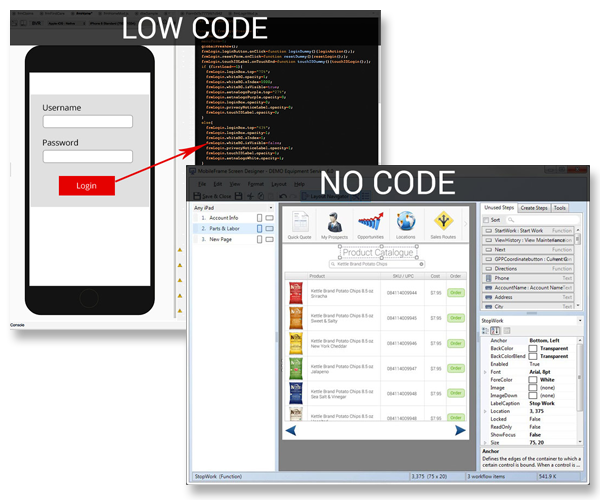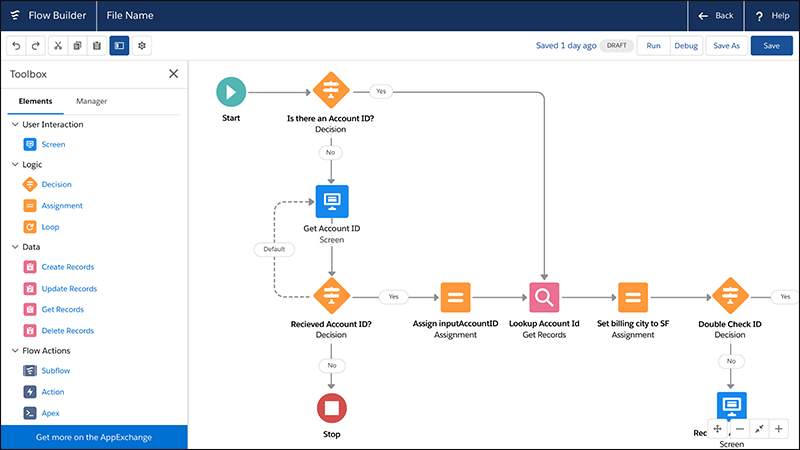Handy Ideas On Choosing Low-code platforms for application development
Handy Ideas On Choosing Low-code platforms for application development
Blog Article
The Benefits Of Low-Code Development For Non-Developers In Terms Accessibility
The following factors are key to making low-code development accessible to non-developers.
Drag-and-Drop Builders. Low-code platforms include drag-and-drop interfaces. This gives non-programmers the ability to create applications in a visual manner, without writing code. The development process is now more accessible to people with no technical background.
WYSIWYG Editors WYSIWYG Editors "What You See Is What You Get" editors help users create workflows or interfaces that look like the final products and make them more understandable.
Simple Workflow and Logic Design:
Visual Workflow Modeling: Users are able to create business processes and application logic through visual flowcharts and models, which are easier to understand than conventional coding techniques.
Pre-built Logic Components: Low-code platforms typically contain pre-built logic components (e.g. statements that are conditional, loops) that can be easily set up, reducing the need for complex coding.
Reusable Components and Templates:
Template libraries that are pre-built: Numerous low-code platforms have a library for the most common kinds of software, giving those who are not developers a base to build on and later modify.
Reusable Widgets and Modules: Users can leverage reusable widgets and modules which can be created faster, reducing the time needed to create them and eliminating the need for technical knowledge.
Tutorials and guide development:
Step-by-Step instructions: Platforms offer tutorials and on-screen help for non-developers building applications.
Interactive Tutorials - Interactive tutorials that let you interact with the platform will aid in learning and increase confidence.
Integration with existing tools
Seamless Integration: Low-code platforms are built to integrate seamlessly with the existing systems and tools in business (e.g. the CRM or ERP) This allows non-developers, to create applications to work within current workflows.
APIs/Connectors: These APIs/Connectors allow non-developers to connect their applications to external services.
Collaboration Features:
Team Collaboration - Features such as real-time collaboration between teams and shared workspaces enable non-developers to work effectively alongside analysts, professionals, analysts and other stakeholders.
Access control based on role: Role levels are able to be set for those who are not developers to make sure they are able to contribute to development without compromising the security.
Automated Testing and Debugging:
Low-code platforms are often equipped with debugging and testing software that automatizes these procedures. This makes it much easier for non-developers to check their applications work correctly.
Error Highlighting: If issues arise the platform flags the errors and suggests solutions by guiding non-developers through troubleshooting steps.
Low-code development is more accessible to non-developers because it allows for democratization of the development process. With its an intuitive, visually-guided tool and experiences, low-code platforms enable business owners to actively contribute and manage applications. Take a look at the top rated go to the website about Low-code Platform for application development for website tips including develop cross platform mobile app, driver jdbc, azure sql databases, rad application development, ms azure sql, stored sql procedures, mobile development platforms, ms azure sql, develop web application, app modernization and more.
Benefits Of Developing Applications Using Low-Code In Terms Of Flexibility And Scale
Low-code application development offers several advantages when it comes to scalability and flexibility, which are vital to build applications that are able to grow with business needs and adapt to changing requirements. Here are the key advantages: Rapid Scaling
Cloud-based Deployment. A lot of low-code platforms offer a cloud-based implementation, which allows the scaling of applications using cloud infrastructure. Businesses can handle more load without having to worry much about administration of servers.
Auto-Scaling Features - Built-in auto scaling capabilities automatically alter resources based on the demand. This ensures consistent performance even in peak times without any manual intervention.
Flexible Architecture:
Modular Application Design: A low-code platform allows for modular design of application. Components are able to be independently evaluated, designed and expanded. Modularity increases flexibility, and makes it easier to update specific parts of an application without having to alter the whole system.
Integration of microservices: The ability to support microservices architecture allows applications to be built as a collection of loosely connected services. This enhances both capacity and flexibility.
Customizable Options:
Extensibility: Low-code platforms typically allow customization of scripts and codes, which allows developers to extend the functionality of applications beyond that available out-of the-box. This enables unique business requirements to be fulfilled without restrictions.
Third-Party Integrations: The integration of third-party services, APIs or other services enables companies to enhance the functionality of their application by adding new functions.
Agile Development and Deployment:
Continuous Delivery and Deployment: Low-code platforms can be used to implement agile methods that allow continuous integration and continuous delivery (CI/CD). This allows for rapid deployment of new features and updates, assuring that the application can be updated quickly in response to feedback from users and market shifts.
Iterative development: Low-code development is iterative meaning that applications can be scaled and improved incrementally. This reduces the risk of large-scale changes while allowing an controlled growth.
Resource Optimization
Efficiency in resource management: Low-code platform tools help optimize resource use by monitoring and managing performance of applications. They ensure that resources are utilized efficiently, and can be increased or decreased in accordance with the needs of the moment.
Load Balancing: The integrated load balancing feature distributes workloads equally among servers. This enhances the application's capacity to handle high traffic and also ensures the same performance.
Global Reach:
Multi-Region: Low-code platform deployments are often accessible across multiple countries, allowing businesses to provide low latency access to every user. This is essential, especially for applications that serve global users.
Localization Support for Localization integrated into the software, allowing applications to be adjusted for different languages or regional demands. This increases flexibility for various markets.
Maintenance and Updates
Simple Maintenance: The graphic and modular nature of low-code applications simplifies maintenance tasks making it possible for updates and bug fixes to be implemented quickly without extensive downtime.
Version Control Version Control: Systems that integrate version control handle rollbacks and changes to ensure that updates can safely be made and that older versions are restored when needed.
Cost Efficiency:
Low Development Costs: By cutting down on the amount of code needed, low-code platforms can lower development costs. This allows to scale up applications without increasing development efforts and expenses.
Pay-As.-You-Go: Many lowcode platforms have flexible pricing models, including pay-as.-you-go. They align prices with usage and growth, allowing financial flexibility.
Overall, the scalability and flexibility advantages of low-code application development let businesses build robust, flexible, and scalable applications efficiently. These platforms enable quick adjustments to changing demands and efficient use of resources and continual improvement, making sure that the application can develop and grow with the business. Take a look at the most popular Legacy application modernization with Low-code tips for site examples including rad development, push alerts, app development platform, develop mobile application, azure sql databases, lowcode no code, app development platform, ms azure sql, develop cross platform mobile app, rad development and more.
Low-Code Software Can Be Beneficial In The Area Of Collaboration And Workflow
Low-code application development is a great choice for businesses who want to improve team efficiency through streamlining development processes. Here are the top benefits: Improved Collaboration Across Functions:
Unified Development Environment: Low-code platforms offer a unified, single environment where all team members comprising business analysts, developers, designers, and stakeholders are able to collaborate efficiently. This helps reduce the number of silos and enhances communication.
Visual Development The platform's visual drag-and-drop capabilities make it simple for non-technical team members to be involved to the design process. It also ensures business requirements are captured correctly and implemented.
Communication Enhancement
Real-Time Collaboration Many low-code platforms include real-time features, such as editing and commenting simultaneously or immediate feedback. This allows for constant communication and can help reduce the time that is spent in a back and forth discussion.
Shared Workspaces Teams can work together using shared workspaces. These workspaces allow them to edit, view and discuss elements of the project.
Streamlined Workflow
Built-in project management tools: Lowcode platforms often come equipped with tools integrated to assist teams in preparing, tracking and directing their growth. This includes assigning tasks, tracking progress, and managing deadlines.
Workflow Automation: The automated execution of routine work, workflows, and other processes minimizes the manual effort required and also eliminates errors. This lets teams concentrate on tasks that are more profitable and boosts efficiency.
More efficient cycles of iteration:
Rapid prototyping. A low-code platform allows quick prototyping. This means feedback can be quickly integrated and improvements made.
Support for Agile Methodologies Supporting agile methods gives teams the ability to work in sprints and continuously provide small amounts of functionalities that make it easier to respond to changes in requirements.
Accessibility for non-developers
Citizen Development: Low code platforms allow business users (citizens developers) to create and modify applications, with no any prior knowledge of programming. This relieves IT and Development teams of burdens and gives them the ability to respond faster to business requirements.
Training and onboarding: Intuitive user interfaces and comprehensive training resources make it easier to bring new members of the team up to speed. This helps improve overall cohesion of the team.
Centralized documentation knowledge sharing, dissemination and documentation:
Integrated Documentation: Low-code platforms include many features that permit the creation and maintaining of documents on the platform. This will ensure that all project information is centrally located and accessible.
Knowledge Repositories. Teams can build and manage knowledge repositories, which include best practices templates and reusable component, facilitating sharing of knowledge and decreasing duplicate effort.
Consistency & Standardization
Standardized Components. The commonality of components across different applications guarantees consistency and makes it easier to work on and be understood by team members.
Governance and compliance: Integrated governance frameworks help ensure that development adheres to organizational standards and regulatory requirements. This decreases the chance of noncompliance, and helps applications comply with quality standards.
Feedback and Improvement Loops
Integrated Feedback: Low-code platforms provide users with integrated feedback mechanisms that allow them to provide users with feedback quickly on their applications. Feedback from users can then incorporated into the application development process.
Continuous Improvement: The capacity to quickly test and deploy changes based on feedback will ensure that applications are constantly developed, while being in tune with the goals and needs of the users.
Visualization, Reporting and Analyzing:
Real-Time Analyses: The built-in reporting and analytics tools provide real-time insight into the project's performance, progress and user interaction, allowing the use of data to make informed decisions.
Visual Workflow Mapping - Visual tools that map workflows and processes can assist teams in optimizing their workflows by identifying bottlenecks.
When it comes to collaboration, low-code applications are an excellent way to simplify workflows, bring diverse teams together, and automate tasks. This results in a more collaborative, agile and efficient developing environment that produces more efficient and high-quality applications.